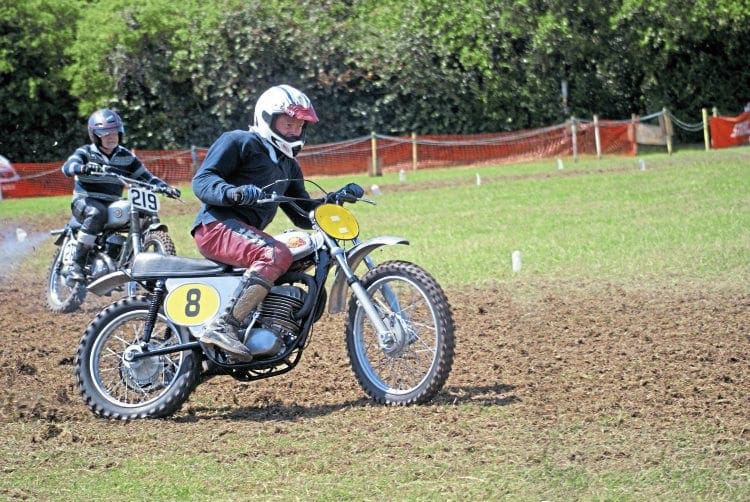Time and time again proof arises that the British industry wasn’t short on ideas or talent. Finance on the other hand… Colin Sparrow looks over the Greeves 500.
Words: Colin Sparrow Pics: Colin Sparrow, Greeves Archive
By the beginning of the 1970s clouds were gathering for the British motorcycle industry and by the end of 1970 Royal Enfield and Velocette had gone, soon to be followed into mergers and eventual oblivion by all the great names.

The hitherto successful Essex firm of Greeves had not been immune to the ills of the industry. They had been forced to cease production of road machines when Norton Villiers stopped making their 4T twin cylinder engines in 1966.
Then, in 1968, the Anglian trials bike and its derivatives came to a halt when supplies of Villiers 37A singles dried up. Their road-racers were no longer competitive and their new trials bike, the Pathfinder, was still in the development stage – and in fact did not start to reach buyers until quite late in 1970.
So for 1969 Greeves developed a pair of new scramblers named Griffons, available in two capacities – the 250cc Model 56 and the 380cc Model 58. Both had single-cylinder two-stroke engines manufactured by Greeves and tubular-steel frames. Launched in February 1969, teething troubles meant that they were not particularly successful when ridden in selected world championship rounds by Arthur Browning and Vic Allan. At home, however, Bryan Wade took the 1969 ACU 250cc Motocross Championship – this in the debut year of the Griffon.
Griffons were clearly competitive machines and sales going into 1970 were strong. Recognising that their only viable future lay in motocross machines, Greeves felt that they needed to build on their success. To attract more interest from buyers they reckoned they needed to succeed at world championship level. The 250 had proved that it was a successful prospect but the 380, although producing 40bhp and fast enough for most mere mortals, was giving away 120cc to the full 500s of the premier class. The works 380 was stretched to 390cc and proved a bit more competitive in Vic Allan’s capable hands. But for a serious challenge for the World 500cc Motocross Championship he needed a full 500.
The project was handed to the Greeves development team, with the brief of producing a 500cc world beater in time for the 1971 season. The team had the backing of engineering director John Ralling and ever-enthusiastic sales director Derry Preston Cobb. With the Griffon in production and selling well, the team could see no problem in developing a suitable frame and running gear, so the focus centred on the power unit. The factory had already started its association with Dr Gordon Blair of Queen’s University, Belfast. Dr Blair had developed a considerable expertise in the computer-assisted design of competition two-strokes. He was already working on Griffon development and was happy to apply the modern approach to the design of the engine for the 500.
With a brief to design and build a full 500 with a projected power output of around 60bhp, the team recognised that they would need to design a bullet-proof transmission, especially as in the competition environment the gearbox was proving to be the Achilles heel of the big Griffon. A robust gearbox was designed by chief draughtsman Tony O’Neill and the decision was made to use a geared primary drive with straight-cut gears direct from crankshaft to clutch. This arrangement of course meant that the engine would have to run backwards. The clutch was a modified version of the excellent all-metal Griffon unit.
With a bore and stroke of 91mm x 76mm giving 495cc, 12.5:1 compression ratio and computer-designed porting, the bottom end too had to be robust. A hefty crankshaft with massive flywheels and three caged-roller main bearings was commissioned from Alpha Bearings. An AJS 7R connecting rod was used and the crankcase and gearbox casing were designed and cast in-house.
The new unit was mounted in a Griffon frame for testing and proved to be as strong as anticipated and with power available from low revs. A number of frame designs, all loosely based on the Griffon component, were tried. They quickly settled on a reinforced version of the Griffon frame but with twin tubes at the front engine mounting and passing beneath the power unit. Testing demonstrated that the new 500 was fast, if tricky to get started with that high compression ratio.
After all that effort, a successful assault on the world championship might have helped Greeves’ fortunes, but by the time the bike was ready for competition in mid-1971, things had changed.
Vic Allan, Greeves’ top ACU-graded rider, had left to ride for BSA at the end of 1970 and their only other graded rider, Arthur Browning, left in July 1971. Also the Pathfinder was not selling as well as they’d hoped so Greeves were having to recognise that they could no longer afford to support riders at international level.
So it was left to their one remaining motocross rider, Dick Clayton, to debut the 500 at the Gloucestershire Grand National in October. He rode it in the first of the two British 500cc Motocross Championship rounds that day. After stalling on the first lap he had fought back through the field to 11th place before he was forced to drop places as the engine lost its edge. He rode his back-up 380 Griffon in the later round.
The 500’s next outing, and indeed finest hour, came on December 15, 1971 when Clayton rode it to second place behind Dave Nicholl’s works BSA in the World of Sport Scramble at Cadwell Park. He also finished a close-fought third in the supporting Brian Stonebridge Trophy race.
An unsuccessful meeting in May was its only 1972 outing and Dick Clayton left at the end of that year. Dave Nicholl, who had been working with the factory on QUB Griffon development, rode the latest version of the 500 to a non-finish in the final ITV scramble at Cadwell Park in January 1973. He was not too impressed and decided to ride Cheney BSAs in 1973. “I think the Greeves has great potential, but my changeover to two-strokes was taking longer than I thought it would.” It was to be the Greeves 500’s last competition appearance.
So just four competition appearances in four years. The question has to be asked: why? It pretty much comes down to insufficient resources and a corporate lack of commitment. With their limited model range, their specialised market and the ever-improving foreign competition, the revenue from motorcycle sales was dropping. So finance became an increasing issue. As Bert Greeves neared retirement he took a back seat, leaving corporate decision-making to his management team. The development team was cut back to four individuals and other work took priority, so they fitted in development of the 500 as and when they could – which meant not very often. In any case without the funding or the riders to make an impact in top-level competition, what would be the point?
The project stagnated to become something that was tinkered with occasionally, and there were certainly no plans to put the model into production.
After Bert Greeves sold the company and retired, the new owners tried to keep motorcycle production going. Then, in 1975 the degree of financial stability afforded by the parent Invacar company evaporated when the Government decided to substitute adapted cars for the invalid carriages and cancelled the contract for their manufacture. Motorcycle sales had fallen as the Griffon design became obsolescent. The decision was taken to cease making motorcycles and produce motorcycle components and accessories.
Tony O’Neill moved to neighbouring company Jack Knight Developments (JKD), taking his experience and know-how with him. The plan was to produce a competition engine based on the 500 and on parallel work by Dr Gordon Blair. A number of engines were produced.
Any remaining Greeves 500 material was sold off. A couple of the engines went to Brian Woolley and Mick Walker who fitted one into a purpose-made road-racing frame for Rolls-Royce technical buyer Bob Stevenson to ride. No great success was achieved. The machine, known as the “Selva”, then passed to Frank Ball who developed it further and raced it in 1973 and 1974. This interesting bike has recently re-emerged, currently fitted with a 350cc Greeves Oulton engine. It was on view at the 2015 Bristol Show.
The 500 scrambler might have gone but it was not forgotten. This is where Dave Harper comes into the picture. Dave was a Greeves’ employee during the Seventies and has an enduring enthusiasm for the marque and for off-road motorcycle competition. Having conceived the idea in 2000, Dave became the organiser of (and brains behind) the Pre-65 Motocross Club Greeves Championship – now in its 15th successful year. With his interest in Greeves, and particularly Griffons, Dave started acquiring late Greeves parts and projects from the 1980s onwards. Over the years a good deal of material came his way.
From well known Greeves enthusiast and collector Andrew King came one of the 500 engine units and one of the frames. With the help of ex-colleague Ray Taylor (who built the frames in the first place), Dave established that he had bought the one that had actually been used in competition. A project was under way.
Over the next decade or so the restoration and reconstruction of the Greeves 500 progressed slowly but steadily as time and funds allowed. The remaining parts were acquired, everything was refurbished and refinished and the Greeves made its public debut at the 2014 Battlesbridge Classic Motorcycle Show. The Essex venue is no more than five miles from the Greeves factory site and so the Pre-65 MX Club lay on a (mainly-Greeves) scrambles demonstration as a show-goer attraction.
For the 2014 appearance, in deference to its rebuilt engine, Dave fitted a plate under the cylinder to lower the compression. This also made it easier to start, which suited the writer who was privileged to be one of the first to try it. All the same, with its reputation of being a bit of an animal, and not wanting to indulge in unintended wheelies, I approached it with a degree of respect. In fact it turned out to be a tractable machine with decent handling and even in detuned form, still produced power on a par with a 380 Griffon.
Dave kindly lent me the bike for display on the Greeves Riders’ Association stands at the 2015 Bristol and Classic Dirt Bike Shows where it attracted a good deal of interest. At the Bristol Show, Gary Gwillam came along from Cornwall with one of the other prototype frames which he has recently found and plans to build up as a second example of Greeves’ mightiest scrambler.
For the 2015 Battlesbridge demonstration the compression plate was removed and the bike handed to former Greeves Series champion Greg Radley. Once pick-up problems were solved by substituting a larger pilot jet, he was able to exploit some of the potential within the confines of the tight demonstration circuit. Plenty of power and loads of torque but a bit more grunt than the chassis could really cope with, was the verdict.
So, yet another British motorcycle story of “what might have been” had the finance and the management commitment been there. Dave will let it out for demonstration runs now and again, but there are currently no plans to race it. As a unique prototype it would be unwise to subject it to the hazards of competition. No doubt it will be seen again at shows. Look out for it, it’s quite a beast.




